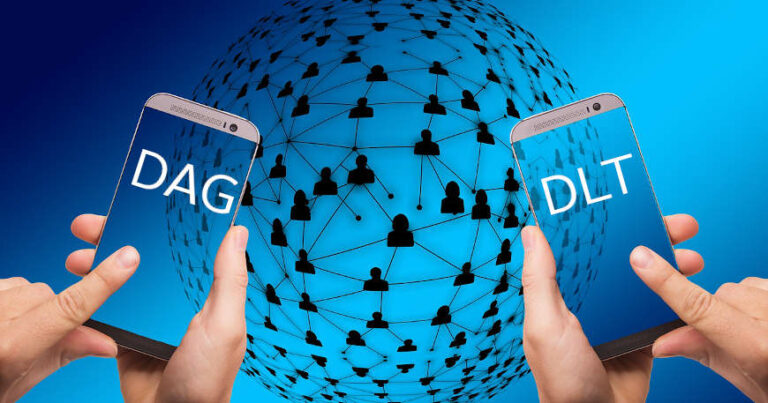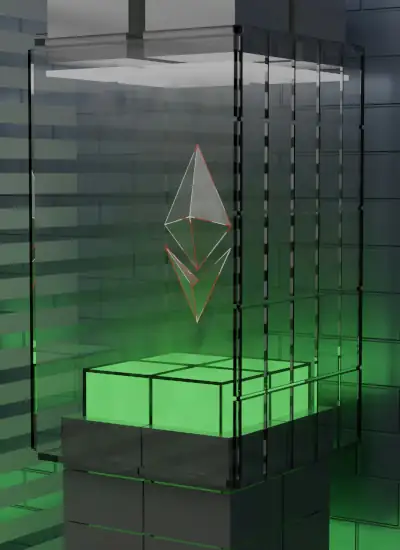
Distributed Ledger Technologies (DLTs) are leading innovations in our world today. With many types of DLTs out there, the debate involving DAG vs blockchain is one of the most prevalent. While many may be familiar with blockchain technologies, little is known about DAGs.
This article has the primary aim of exploring what DAGs are, their advantages, and use cases. Before we delve into all these, let us begin by exploring the differences between both technologies.
DAG vs blockchain: what is the difference?
The world has been transformed in more ways than one through distributed ledger technologies (DLTs). However, many people only attribute blockchain technologies as the only type of DLT around today. This is wrong as Directed Acyclic Graphs (DAGs) are also notably an innovative offshoot of DLTs. If you were not aware of this fact, then you dive into our blockchain explained article first.
Both technologies have their marked differences. In practice, directed acyclic graph and blockchain technologies register data or transactions on a digital ledger. The duo can be also either be distributed or decentralized. Amongst other converging similarities include the possibility for both systems to develop a token economy. This makes it possible to incentive network participants through cryptocurrencies.
Both DAG and blockchain are often pitched as rivals. DAG proponents believe the tech is a better version of blockchain. DLT is very trendy as we can see it’s increasing on the Gartner Hype Cycle Blockchain. In this article, we will dive deeper into what DAGs are and their use cases with the latest blockchain trends. We will also draw out the major differences with blockchain technology. By doing this, we will begin to gain appreciation by understanding that both techs are here to complement each other.
What is DAG technology?
A Directed Acyclic Graph (DAG) is a unique type of data structure. DAGs typically connect different pieces of information together. We can visualize as DAG protocol as a sequence of spheres and lines connecting them. The lines are unidirectional, implying that info cannot move in opposite directions. In fact, any information in the DAG cannot move back to its source, if we follow the direction of the graph.
In the digital currency context, the spheres can be likened to a transaction. These transactions are structurally built on one another, a deviation from building into blocks in blockchains. While complicated mining is required in some blockchain networks, these are unnecessary in a DAG. Nonetheless, a node is required to vet new additions, as well as confirming or validating old transactions.
For a new transaction to be registered in a DAG, it must reference older similar transactions. Typically, two things happen at the point of recording transactions on the DAG. Older transactions are referenced as noted and they are also confirmed at the same time. Let us consider this analogy. Michael makes payment and the details are billed to be stored in a DAG network. This way, previous payments which typically are always unconfirmed will be referenced, similar to how blockchains reference old transactions. However, unlike in the blockchain, the transactions are confirmed without any hassles.
Michael’s transactions will also automatically be registered as unconfirmed, for the next set of transactions to continue the cycle. Additional details regarding this DAG’s transaction validation will be discussed shortly.
DAG advantages
DAG is a new protocol as much as blockchain technology is. However, many have touted its uniqueness as even more revolutionary. Hashgraph is for example is a distributed ledger technology that uses DAGs to create an asynchronous Byzantine Fault-Tolerant (aBFT) consensus. Here are some of the inherent advantages of this new technology.
Speed
High transaction speed accounts for one of the major advantaged of a Directed Acyclic Graph. As described earlier, any user can broadcast transactions on the network and get a confirmation at the same time. In a typical blockchain network, there is a time-lapse or waiting period between when a transaction is logged and when it is confirmed. This is known as block time. These block times are non-existent in a DAG system, eliminating all forms of delays. Users can also register as many transactions as they want, provided older transactions are validated.
Easy Scalability
The subject of scalability is a worrying challenge in most Proof of Work (PoW) blockchain networks. Continuous addition of new transactions can hamper the decentralization tenet that sustains the network. For scalability to be attained in a proper blockchain network, the number of nodes may also be required to increase. This is always not practicable, and as such, leads to increased block times as miners are overwhelmed.
The emergence of DAGs solves these scalability issues and offers adequate throughput as they are not limited by block times. Directed Acyclic Graphs can process an increased number of transactions per second (TPS) compared to a traditional blockchain.
Absence of Mining
Unlike the mining process adopted by Bitcoin, Ethereum, and other coins as their consensus algorithm, DAGs are free of mining. While PoW is not bad in itself, its absence contributes to the efficiency of DAGs in recording transactions. Ethereum for example will launch ETH 2.0 soon for creating smart contracts. It will change from PoW to PoS consensus model and sharding will also be a part of the new network.
Cost-Effectiveness
Using DAGs has proven to be more cost-effective than the major public blockchain options around today. The protocol has no miners that must be incentivized before transactions can be confirmed. This reduces the overall pressure and encourages the addition of more transactions without the fear of increased charges.
In particular, in the Ethereum network, high network or transaction fees have largely made the blockchain expensive to use. At the peak of the network congestion, sending $100 cash can incur a gas fee of about $20. Other emerging blockchain infrastructure has come to solve this gas fee challenge. However, they have all been unable to offer low fees and scalability without hitches. Considering scenarios like these is why DAG proponents posit that the tech has come to topple blockchains.
Energy Efficiency
DAG projects or protocols do not use the PoW consensus mechanism with its high energy consumption. This has positioned all direct acyclic graphs as more environmentally friendly alternatives compared to PoW-powered blockchains.
The energy efficiencies of DAGs are particularly important as climate change narratives are becoming a concern around the world. The role of cryptocurrencies particularly BTC and other DLT backed technologies in climate change is also being profiled. With DAGs, such energy use concerns will be alleviated.
DAG disadvantages
DAGs are unique in their own ways, and they solve most of the inconsistencies of blockchain technology. However, they also possess some flaws. Two of these flaws are x-rayed below.
Possesses Elements of Centralization
DAG protocols are not always fully decentralized. A good number of these protocols rely on third parties to bootstrap the system. These third parties breed centralization and can thus limit the overall security of the system. This is a drawback when compared to protocols that thrive in blockchain ecosystems.
Broad-scale Testing Non-Existent
The clamor for the superiority of DAGs in processing large transactions is typically based on their structures. Large-scale transactions as we have in blockchain networks have not been done to validate the claims of its superiority. Until the adoption level is at scale, we cannot categorically tell if DAGs will not come up with similar scalability issues. This makes the claims that DAGs are like Blockchain 3.0 is more of an unproven hypothesis.

Unlock Your Business Potential with Certified Blockchain Consulting!
Dive into the future of technology with our team of certified blockchain experts. Simply pick the service you need:
Personalized Advice – tailored to your business needs.
Comprehensive Training – for you and your team.
Development Services – innovative solutions from the whitepaper to the finished blockchain.
Programming – with capabilities and tools to succeed.
TALK TO THE EXPERTS TODAYWhat makes DAG and blockchain different?
Having explored what DAGs are, let us now highlight their major differences when compared to blockchain technologies. The major differences we would be x-raying borders on mining, TPS, Time of Launch, Transaction Validations, Data Structure, and notable networks running on both technologies.
Let us look at each one in brief.
Mining process
Mining in this context is generally the process of approving transactions in a blockchain while generating new coins in return. Through this process, miner solves complex computations using specialized hardware. The successful miner gets to confirm and add transactions to the new block and earns tokens for his efforts.
Besides mining, blockchain networks can also attain consensus through the Proof-of-Stake model. Here, the role of miners is taken over by validators. Attaining consensus here is dependent on the value of stakes (locked tokens) you have in the network.
- Blockchain: Participants have the ability to mint new tokens via different consensus mechanisms
- Directed Acyclic Graph: The previous transaction validates the succeeding to achieve consensus
These elaborate measures are absent in DAGs. The older transactions are needed for consensus to be achieved. DAG users are however poised to confirm transactions with a huge weight. This typically means the transaction path with numerous, proven successfully confirmed transactions. When users want to confirm a transaction, they tend to look through the different connected lines to the first transaction. This is to ensure that the new transaction has enough funds for the current transaction to clear.
Transaction lodgers whose has insufficient balances risk their transactions ignore. This can affect future transactions from the same users.
Transaction speed
Blockchain technologies are known to be faster, however, DAGs are relatively faster. Block or waiting times as inherent in blockchain technologies are absent here, guaranteed faster transaction speed.
Blockchain technology has a fewer number of transactions per second in terms of scalability. The unique data structure of DAGs however permits a large number of transactions to be added with improved scalability.
Data Structure
Verified data in a blockchain system is contained within blocks, linked together in a series of an unending chain of blocks. Placing new data in each block is dependent on existing transactions and they are all sealed using encryption. In a DAG, the data are stored independently, as a layer atop one another.
Transaction validation
The decision to either approve or disapprove a transaction is vested on the miners or validators in a blockchain system. In a DAG protocol, however, the success of a transaction depends on its ability to approve previous transactions.
Launch date
There’s a big difference in the journey onto maturity for both technologies as it relates to their respective time of launch. Blockchain was first introduced in 2008 when Satoshi Nakamoto anonymously released the Bitcoin whitepaper. NXT was the first platform to leverage DAGs, and it came to the limelight in 2015.
Popular networks
There are numerous networks currently utilizing blockchain technology today. Bitcoin, Ethereum, Tezos, IOTA are some of the few networks running on a blockchain. Other private startups or organizations also have private networks utilizing blockchain technology.
Unlike blockchains, Directed Acyclic Graphs have a fewer number of networks running on them. The most popular, however, include, NXT, Tangle, and Byteball.

Unlock the Code: Master Blockchain Programming!
Dive into the world of decentralized technology with our comprehensive online programming courses. Learn at your own pace and get:
Access – to expert instructors.
Interactive – coding exercises.
Vibrant – community of like-minded learners.
Certified – receive your recognized diploma.
ENROLL TODAY AND TRANSFORM YOUR FUTURE!Is DAG better than blockchain?
As has been pointed at thus far, both blockchain technology and DAG have similar features as well as their differences. The question of which is better is dependent on the use case in which it is deployed. Based on this use case profiling, both have their advantages and disadvantages. This is explored in the following section.
Blockchain vs DAG: use case comparison
In the table below, we will give an overview of some unique use cases for both technologies. We will also showcase and give the reasons why each technology is best for each use case chosen. It should be remembered, however, that both DAGs and blockchain technologies have their strengths and weaknesses. These largely play out in their use case comparison also.
| Use Cases | Blockchain | DAG |
|---|---|---|
| Internet of Things (IoT) | NO | YES |
| Microtransactions | NO | YES |
| Large Payments | YES | NO |
| P2P Energy Trading | NO | YES |
Internet of Things (IoT)
At the pace of the current technological advances, the IoT system is becoming so widespread. Connected devices with capabilities to access various distributed services which may involve payments are becoming commonplace. Imagine a scenario where you seamlessly pay for your fitness program using your smartwatch and its integrated payment system. Millions of people could be doing similar transactions per time around the world. This requires a fast and cheap payment infrastructure. This is where DAGs come in and exercise superiority over blockchains.
Microtransactions
People now pay for regular items like a cup of coffee using digital payment options in the real world. The coming of blockchain technology has stirred the creation of crypto-based payment options. However, these new currencies can be very limiting. Bitcoin processes an average of 4 to 7 transactions per second. Ethereum does a few thousand per second. Other improved blockchain networks raised the bar, but none can match the demands of microtransactions. The data structure of DAGs and the low fee permit make it suitable for such transactions involving small cash.
Large Payments
There are instances where one needs to make large transactions such as buying a property. In this scenario, blockchain technology is ideal as the tiny fees are not of much concern. Data security is key in this regard, perhaps keeping off third-party brokers and their exorbitant fees. As we have said in this article, DAGs are not as secured based on their semi-centralized nature. This makes blockchain the go-to option for large payments.
P2P Energy Payments
Energy consumption is one of the basic needs for households and businesses today. There is often an imbalance in energy generated and consumed, creating room for energy exchange. At present, there are a growing number of secure platforms that help facilitate this trading. Payment in these systems is often in bulk and but low-value. An easily scalable platform is thus needed to boost such an ecosystem. This makes DAGs the preferred option for this use case.
Key takeaways
There are a variety of Distributed Ledger Technologies around today. Of these, blockchains and Directed Acyclic Graphs (DAGs) are some of the most related. These two technologies share some similarities, albeit, with marked differences. DAGs have been touted as an improvement and the future of blockchain technology. Both have use cases in which their uniqueness is best showcased. This understanding can be harnessed by developers building innovative solutions today.
Distributed Ledger Technology has already surpassed the worst challenges in its potential growth push, and we may begin to see more mainstream firms begin to incorporate it into their business processes moving forward. If you like to implement DLT as well then talk to one of our experts.
Learn Distributed Ledger Technology!
Book a Training
Watch our Webinars
Enroll in DLT Courses
Become a Pro yourself
Get free DLT Tips!
Get monthly DLT tips.
On top, you’ll get our free blockchain beginners course right away to learn how this technology will change our lives.


